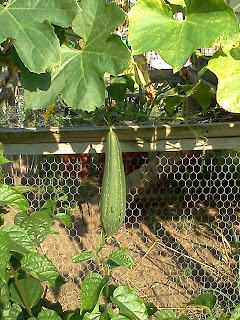This one is from Dripping Springs Ollas in the Texas Hill Country. The Olla is placed in the garden bed- or container- with the soil up to the neck. Then, keep the jug filled with water, and plants to about 15" away from the Olla will be watered.
On October 18, I decided to plant salad greens in a large tub with my Olla. I mixed the soil I wanted to use and started to fill the tub.
I set the Olla so when the tub was filled the top would be about even with the rim of the tub. Since salad greens aren't deeply rooted plants, I didn't need the tub filled to the brim with soil mix. Then I finished filling the tub and planted the transplants.
This is how it looked upon finishing planting. I watered them in with a hose to get them situated. I found I did need to water with a hose a couple of times for about the first 10 days. The weather was hot with no rain.
Below, is how my Olla Tub Garden looked on November 2, 15 days after planting. Now, I only need to keep the Olla filled, which I do about twice a week. Since the roots aren't very deep, I've found I need to keep the water level topped off in the jug.
I've already harvested some of the greens, and they are quickly regrowing for further harvests of succulent, tender and tasty salad greens.
When I first got my Olla, I did some reading about this method of gardening and found it's used all over the world, especially is very dry areas like North Africa, China, Central Asia, Mexico, Central and South America as well as the desert Southwest in the United States.
There are varied themes on this same principle. YouTube has quite a few videos and people have posted other ways to create a self watering pot in the garden. Here are some references:
Global Buckets
Urban Homestead
Olla Irrigation
Tree Hugger, Unglazed Clay Pots Create Efficient Irrigation
Until Next Time- Good Gardening to you!































